Salcido A. (ed.) Cellular Automata - Simplicity Behind Complexity
Подождите немного. Документ загружается.

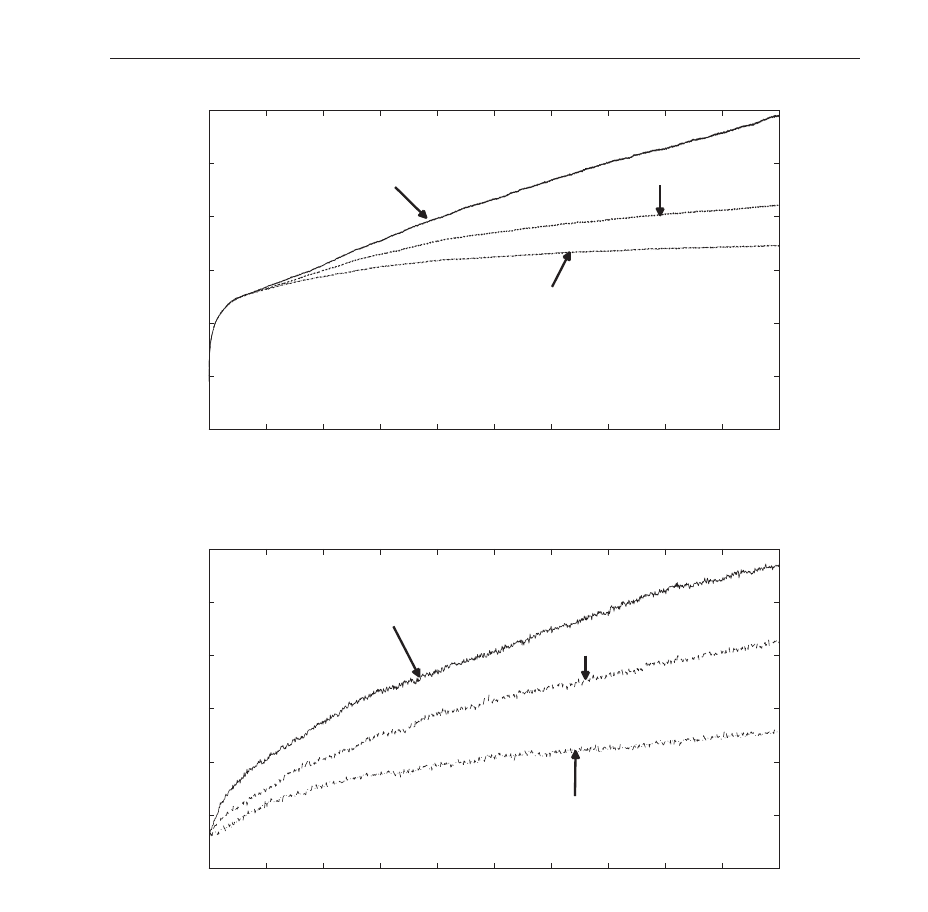
0 1000 2000 3000 4000 5000 6000 7000 8000 9000 10000
0.02
0.04
0.06
0.08
0.1
0.12
0.14
number of steps
entropy per number of excited cells
R=0.25
R=0.50
R=0.75
Fig. 7. The same as in Fig.6 but for p
a
= 1.00 and p
e
= 0.25.
0 100 200 300 400 500 600 700 800 900 1000
0.041
0.042
0.043
0.044
0.045
0.046
0.047
number of steps
entropy per number of excited cells
R=0.25
R=0.50
R=0.75
Fig. 8. The same as in Fig.7 but for random initial conditions.
values of the reflection probability. For R
= 0.50 and 0.75 we observe slowly growing value
of
E whereas for R = 0.25 the increase is more pronounced. This behaviour is similar to that
shown in Fig. 6, but one should note that the time-scale we d iscuss here is by one order of
magnitude greater then previously. This is a result of the fact that the absorption probability
is assumed to be unity. For this case the whole system’s evolution slows down considerably
and this is the mentioned earlier molasses effect.
427
Cellular Automata – a Tool for Disorder, Noise and Dissipation Investigations

Fig.8 presents the time-evolution of E for random initial conditions. For this case it is assumed
that for t
= 0, the excitations are randomly distributed along the whole system. As a result,
the initial values of entropy are comparable to its final ones, contrary to the previous cases
(deterministic initial conditions) where
E started its evolution practically from zero value.
Moreover, the entropy time-variations have noisy character and now we shall concentrate on
it.
One of the methods for investigation of systems in which some kind of disorder appears
is that based on the autocorrelation function (AF). This function, frequently used in signal
processing, measures the existence of correlations of the signal with itself but shifted in time
scale backwards for a specified time value. The function can confirm the existence of any
repetitive patterns in the signal analysed, even if they are obscured by any kind of noise that
affects the signal considered.
AF can be used to trace the degree of disorder that emerges during evolution of the system
we are dealing with. If our system is initially ordered, we can try to find whether during
the evolution under various conditions applied (as absorption and emission probabilities or
refraction probability of resonator mirrors), the system becomes disordered or not. If there are
such conditions that would force the excitations to spread inside the resonator in any periodic
way, the autocorrelation function notes that fact.
The definition of the autocorrelation function used comes from the relation (Bendat & Persol
(2010)):
C
(τ)=
1
N −1 −τ
N−1−τ
∑
i=0
a
i
· a
i+τ
,(4)
where τ is the time delay, N is the number of elements in series and a
i
is the value of the i −th
element of the series analysed. If the autocorrelation coefficient is to be normalised, it should
be additionally divided by the value of C for τ
= 0 and in this paper such normalised AF is
used.
For the cases discussed here the autocorrelation function will be applied as a measure
of correlations between the entropies corresponding to various moments of time.
Autocorrelation function measures the character of changes in entropy with time. We shall
examine two extreme cases for both random and deterministic initial conditions: the former
corresponds to maximal absorption and small emission probabilities (Fig.9 and Fig.11) and
the latter to small absorption and maximal emission probabilities (Fig.10 and Fig.12).
We start our consideration from the case when the molasses effect is dominant in the system.
This situation corresponds to the assumed maximal absorption and relatively small emission
probabilities. For deterministic initial conditions (Fig.9) we can see slow decay of AF with
increasing time-shift τ parameter, since the entropy is a slowly increasing function of time.
It means that the system during its evolution becomes more disordered than it was at the
beginning , but this process is rather slow. In contradiction to the opposite probability values
(Fig.10 – p
a
= 0.25 and p
e
= 1.00) we can observe practically no changes in longer time.
The reason is that the entropy reaches its high value almost instantly and the system initially
ordered very quickly becomes disordered. After that any changes in
E are rather slow in
character as we compare them with its initial growth. For this case we can differentiate AF
corresponding to various values of R much more easily than for the previous case. This is a
result of the fact that for this case AF is almost constant and when the value of τ becomes
428
Cellular Automata - Simplicity Behind Complexity
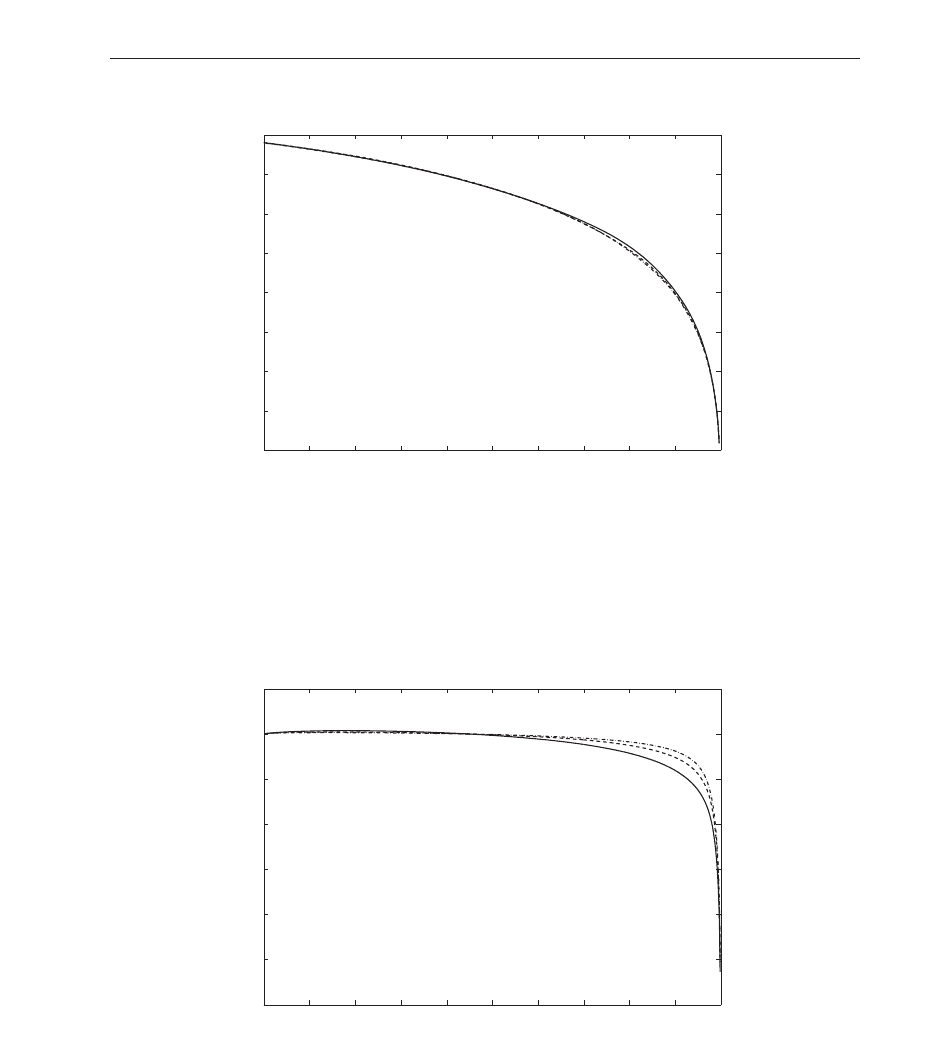
500 550 600 650 700 750 800 850 900 950 1000
0.65
0.7
0.75
0.8
0.85
0.9
0.95
1
time delay
autocorrelation for entropy
Fig. 9. Entropy autocorrelation function v. time-delay parameter τ,forvariousvaluesofthe
reflection probability R: s olid line – R
= 0.25, dashed line – R = 0.50 and dashed-dotted line
–R
= 0.75. Other parameters are: p
a
= 1.00, p
e
= 0.25. Deterministic initial conditions are
assumed.
0 100 200 300 400 500 600 700 800 900 1000
0.4
0.5
0.6
0.7
0.8
0.9
1
1.1
time delay
autocorrelation for entropy
Fig. 10. The same as in Fig.9 but for p
a
= 0.25, p
e
= 1.00 and various values of R: solid line –
R
= 0.25, dashed line – R = 0.50, dashed-dotted line – R = 0.75.
429
Cellular Automata – a Tool for Disorder, Noise and Dissipation Investigations
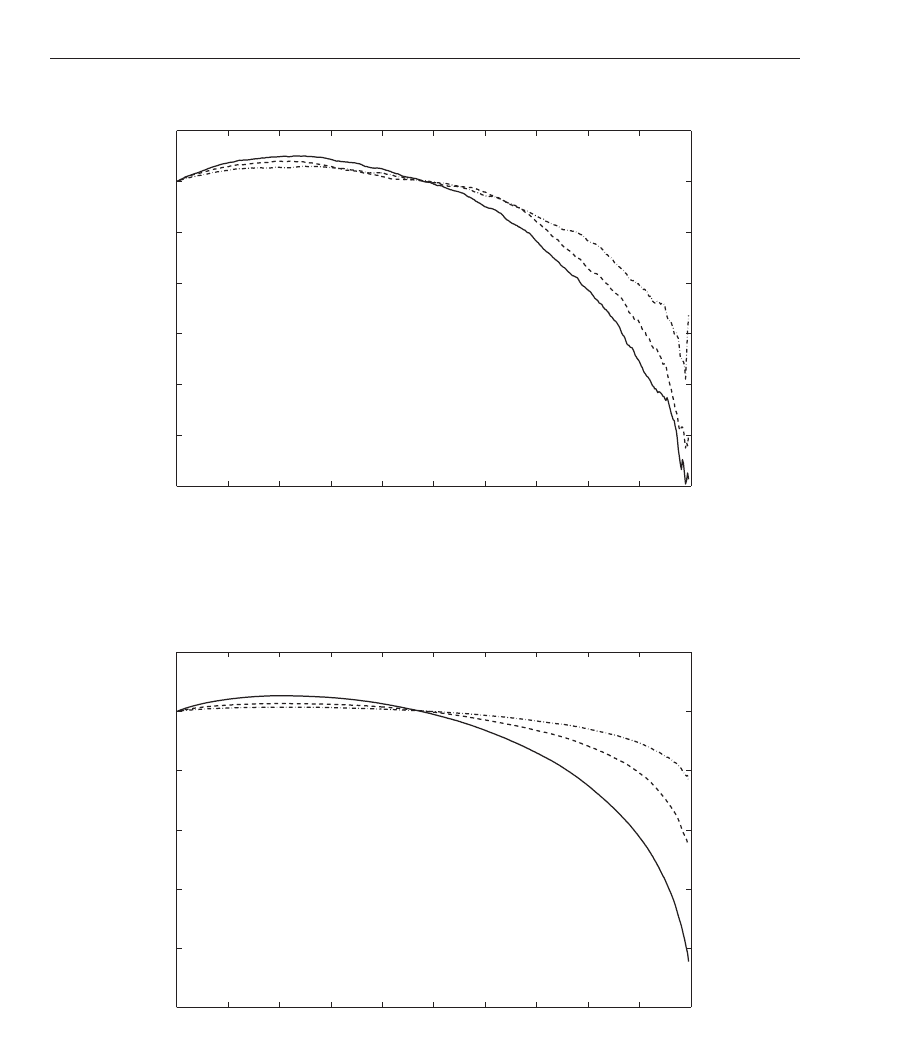
0 50 100 150 200 250 300 350 400 450 500
0.994
0.995
0.996
0.997
0.998
0.999
1
1.001
time delay
autocorrelation for entropy
Fig. 11. The same as in Fig.9 but for random initial conditions.
0 50 100 150 200 250 300 350 400 450 500
0.95
0.96
0.97
0.98
0.99
1
1.01
time delay
autocorrelation for entropy
Fig. 12. Entropy autocorrelation function for the same parameters as those of Fig.10 but with
random initial conditions.
430
Cellular Automata - Simplicity Behind Complexity

close to the cavity dimension this function falls rapidly. This decrease appears more suddenly
and is more rapid as the probability of reflection increases. Such behaviour is caused by
greater velocity of the excitation movement – the excitations reach the “mirrors” faster than
it was for maximal absorption probability case. This leads to the visible differences in the
dynamics of energy leakage from the cavity.
The analogous features can be seen for the random initial conditions cases (Fig.11 and 12), but
the changes in AF are very tiny as we compare them with those corresponding to the ordered,
deterministic initial conditions. One should remember that the excited cells are initially spread
along the whole cavity. Even when the absorption probability reaches its maximal value, the
energy quanta can escape from the cavity sooner than it was for the case of deterministic
initial conditions. For both values of absorption and emission probabilities we can also see
some initial small growth in AF but one should keep in mind that the vertical axes scale
appearing in Figs.11 and 12 is much more stretched as we compare it with those in Fig.9
and 10. However, such small increase in the AF value is an effect of short-time entropy vs.
time regular dependence at the beginning of the entropy growth process. However, after this
short period of time, entropy becomes an irregular function of time and AF decreases.
3.3 Recurrence plots
As shown, the system discussed here can exhibit complicated evolution. To determine its
character, we can apply the recurrence plots (RP) analysis. This investigation method allows
determination whether the system evolves chaotically, exhibits regular or periodic dynamics
or finally, is subjected by some noise. Moreover, RP can be applied for the situations when
we cannot obtain sufficiently long time-series. For explanation of the RP idea one can see
the review paper Marwan et al. (2007) and the references quoted therein.TheideaofRPwas
proposed by Eckmann et al. (1987) and is widely used in nonlinear data analysis up to now.
To build RP we need to find the binary matrix. Its elements are defined by the formula
(Eckmann et al. (1987)):
R
i,j
= Θ(
thr
−||x
i
−x
j
||), i, j = 1,...,N, x
i
,x
j
∈R,(5)
where Θ is the Heaviside function,
thr
is the threshold parameter, and || || denotes the
norm. This norm allows determination of the distance between two points. To determine this
matrix we need to reconstruct the trajectory in the phase-space on the basis of the time-series
we investigate. The modulus
||x
i
−x
j
|| determines the distance between the points in the
reconstructed phase-space. If two points fall inside the same region (sphere of the radius
thr
) they are labelled by 1, otherwise they labelled by 0. Applying this procedure we obtain
a matrix filled with zeros and ones that can be illustrated by white and black point. If we
reconstruct the phase space in which the system analysed lives, we look for times at which
system returns to the same area of that phase space. In fact, RP shows whether the system
analysed via the time series inspection recurs or not. Analysis of the so obtained matrix
(picture consisting of the black and white points) allows determination the dynamics we are
dealing with.
In this chapter we present RP for automaton determined by random initial conditions where
the excited cells are randomly spread over the whole system. Moreover, we shall discuss the
cases of the cavity with cyclic boundary conditions and that of the cavity confined by the
“mirrors”. Since, the energy of such a cyclic model is preserved we shall concentrate at this
point on the entropic parameter
E time-evolution. This “entropy” describes how disordered
our system is and RP based entropy analysis gives us information about the character of
431
Cellular Automata – a Tool for Disorder, Noise and Dissipation Investigations

changes in E. The type of such variations should reflect the character of the whole system’s
dynamics. Excitation movements along the “cavity” are determined by the absorption and
emission probabilities that influence the derived RP as well. RP derived on the basis of our
model should clarify the nature of the system evolution despite the complex form of this
evolution. Many features are obscured by the random processes taking place in the system
and we shall show that RP can reveal them.
At first, let’s concentrate on the cyclic boundary conditions and compare two extreme
cases: maximal absorption with small emission and maximal emission with small absorption
probabilities. The time-evolutions of entropy and the corresponding RP for all cases discussed
in this section are plotted. The character of evolution of
E is similar to those discussed in the
previous section (Figs.15 and 16) if we assume that the system is confined by the mirrors.
For cyclic boundary conditions, the entropy exhibits random deviations from some constant
value. If we neglect them the entropy can be treated as constant (note the scale of vertical axis
in Figs.13 and 14). However, the question arises whether these random deviations originate
from noise effects or some deterministic chaotic features can be expected. Moreover, it would
be desirable to check whether any quasi-periodic or periodic evolution are hidden behind the
“noisy” view of
E evolution. Therefore, these entropies are plotted with the corresponding
RPs.
As follows from the recurrence plot shown in Fig.13 (p
a
= 1.00, p
e
= 0.05), the entropy
evolution has a rather noisy than chaotic character. Although some diagonal lines appear, but
they are formed of a few points only (average: 2.5 points). Since the length of the diagonal
lines is related to the value of the sum of positive Lyapunov exponents, short lines indicate
that we have not chaotic behaviour in this case. We see that in the system the noise effects are
dominant over the chaotic ones. This observation agrees with the fact that for the situation
discussed here, the fraction of all of the points that form the diagonal lines is about 8%. This
indicates that a significant number of the points that recur are practically isolated ones. All
these features confirm that the entropy changes are of noisy character. For the case when
p
a
= 0.05, p
e
= 1.00 (see Fig.14) again the entropy vs. time-evolution of E should be classified
as a noisy signal. For this case the percent of points forming diagonal lines is smaller than it
was observed previously. It means that for both extreme cases initial random conditions result
in a noisy character of entropy dynamics.
Next, we change the boundary conditions from the cyclic ones to those corresponding to the
cavity with mirrors. Although for this case the dissipation processes is included, we shall
discuss the character of the entropy evolution again. This allows a comparison of the results
with those discussed above for the cyclic conditions. Fig.15 shows the entropy evolution and
the corresponding RP for the probability of reflection R
= 0.75. Moreover, it is assumed that
p
a
= 1.00, p
e
= 0.10 and the cells are initially randomly excited. The plot of E(t) (Fig.15
– top) has the same irregular character as that for the cyclic conditions. The only difference
is in the initial growth of entropy. Nevertheless, from the form of this plot we are not able
to say anything on the character of the time-evolution. However, analysis of RP (Fig.15
– bottom) shows that the dynamics of the system differs considerably from that discussed
earlier. Both horizontal and diagonal lines forming rectangular structures are observed. They
are dominant over single dots characteristic of noise, and they are a result of some periodic
and quasi-periodic effects and drift ones (logistic map is corrupted with a linearly increasing
term). Moreover, the plot shows some features characteristic of the Brownian motion. Periodic
effects are related to the finite length of the cavity and a finite constant velocity of the excitation
432
Cellular Automata - Simplicity Behind Complexity
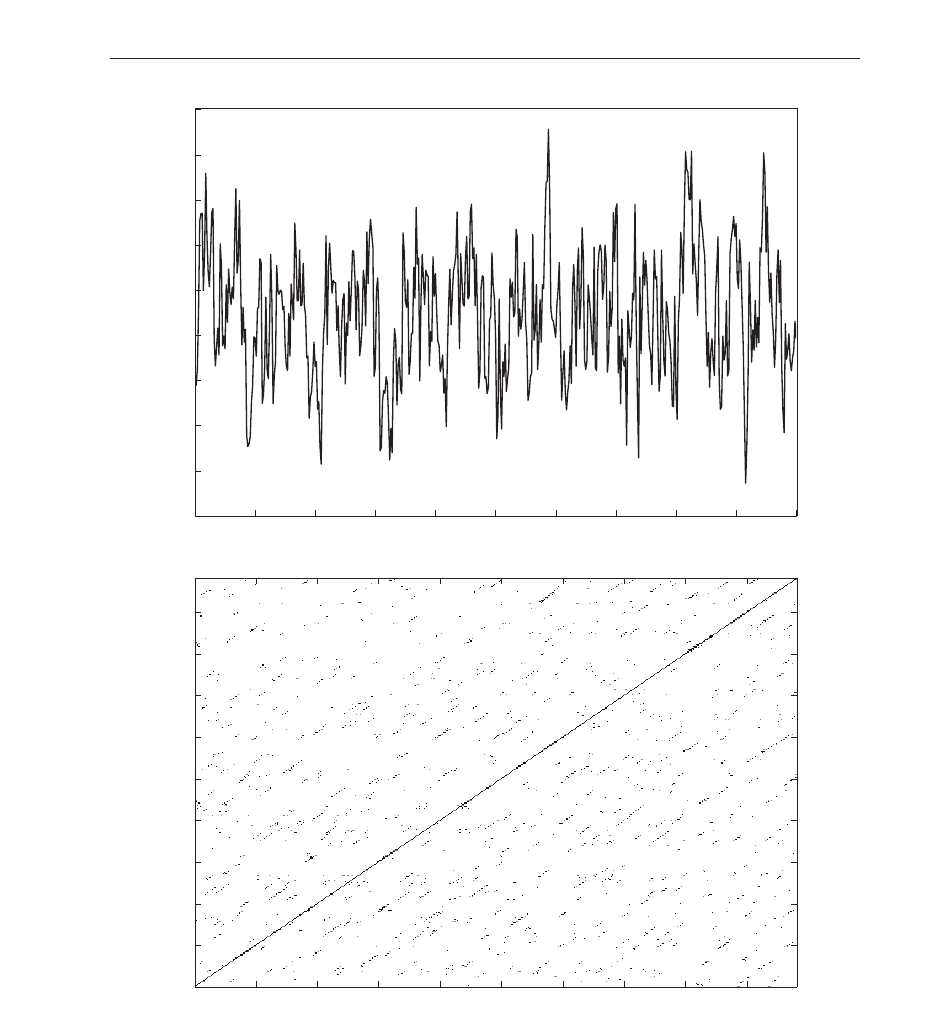
0 50 100 150 200 250 300 350 400 450 500
4.146
4.148
4.15
4.152
4.154
4.156
4.158
4.16
4.162
4.164
number of ste
p
s
entropy
50 100 150 200 250 300 350 400 450
50
100
150
200
250
300
350
400
450
Fig. 13. At the top the entropy for p
a
= 1.00 and p
e
= 0.05 and cyclic boundary conditions.
At the bottom the recurrence plot corresponding to the entropy evolution. We assume
random initial conditions.
433
Cellular Automata – a Tool for Disorder, Noise and Dissipation Investigations

0 50 100 150 200 250 300 350 400 450 500
4.146
4.148
4.15
4.152
4.154
4.156
4.158
4.16
4.162
4.164
4.166
number of ste
p
s
entropy
50 100 150 200 250 300 350 400 450
50
100
150
200
250
300
350
400
450
Fig. 14. The same as in Fig.13 but for p
a
= 0.05 and p
e
= 1.00.
434
Cellular Automata - Simplicity Behind Complexity
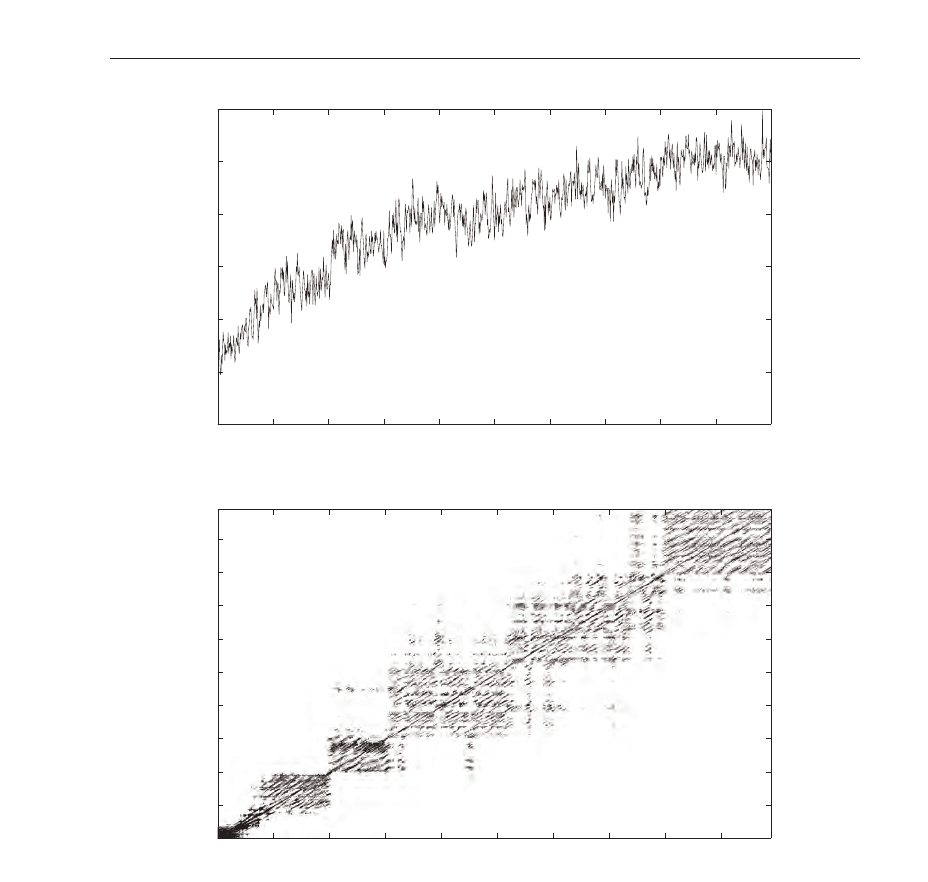
0 100 200 300 400 500 600 700 800 900 1000
4.14
4.15
4.16
4.17
4.18
4.19
4.2
number of steps
entropy
100 200 300 400 500 600 700 800 900
100
200
300
400
500
600
700
800
900
Fig. 15. The same as in Fig.13 but for the cavity with mirrors, R = 0.75, p
a
= 1.00 and
p
e
= 0.10.
movement (the excitations “oscillate” from one end of the cavity to another). The leakage
of the energy from the system moderates the noise effects and permit uncovering of other
features. Moreover, for this case the time-evolution becomes more regular than for the case of
constant energy, when many excitations moved randomly inside the cavity.
If energy leakage is increased (R
= 0.25), the time-evolution of E looks similar to that
discussed for R
= 0.75 (Fig.16 – bottom). However, RP form indicates different character
of this evolution. We see that horizontal lines forming rectangular structures again, however
435
Cellular Automata – a Tool for Disorder, Noise and Dissipation Investigations
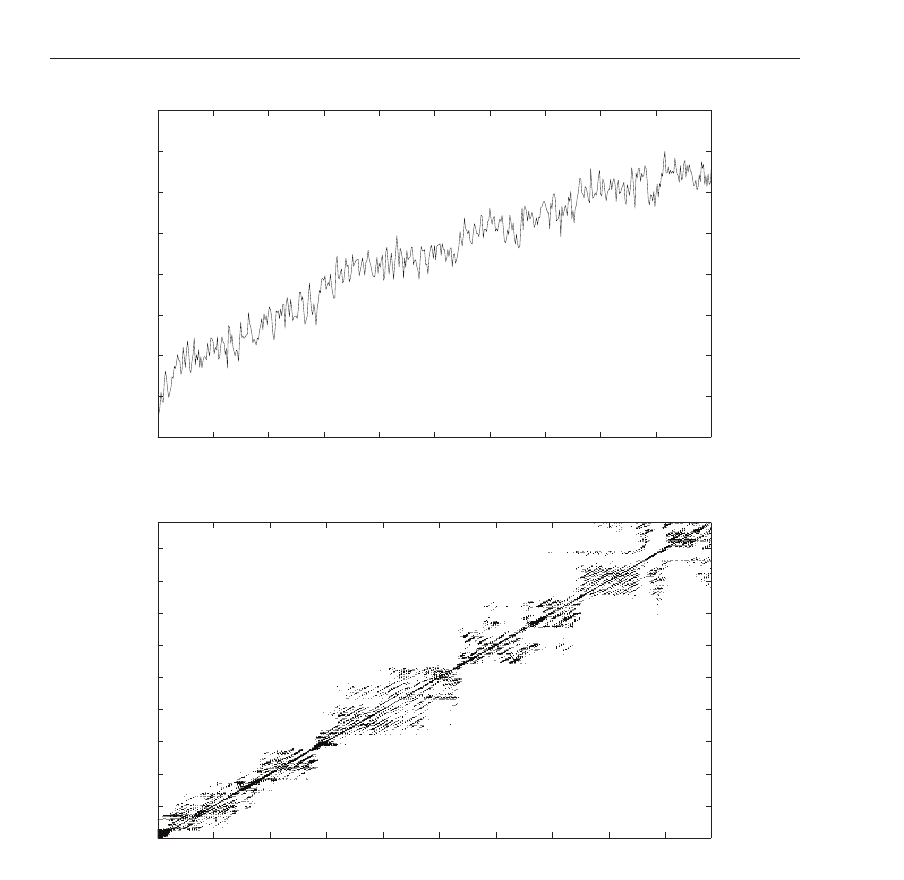
0 50 100 150 200 250 300 350 400 450 500
4.15
4.16
4.17
4.18
4.19
4.2
4.21
4.22
4.23
number of steps
entropy
50 100 150 200 250 300 350 400 450
50
100
150
200
250
300
350
400
450
Fig. 16. The same as in Fig.15 but for R = 0.25.
they are much closer to the main diagonal then in the former case. This means that the system
has stabilized itself and there are some regular oscillations inside the cavity. Moreover, there
are some diagonal lines, but they are very short and sparse. In fact, during the evolution
many energy quanta escapes the system, so fewer excitations remain inside the cavity and
their oscillations becomes more distinct.
The results have shown that CA evolution described by RP can exhibit many interesting
features. Thanks to the application of RP, we can detect and classify various types of the
436
Cellular Automata - Simplicity Behind Complexity
